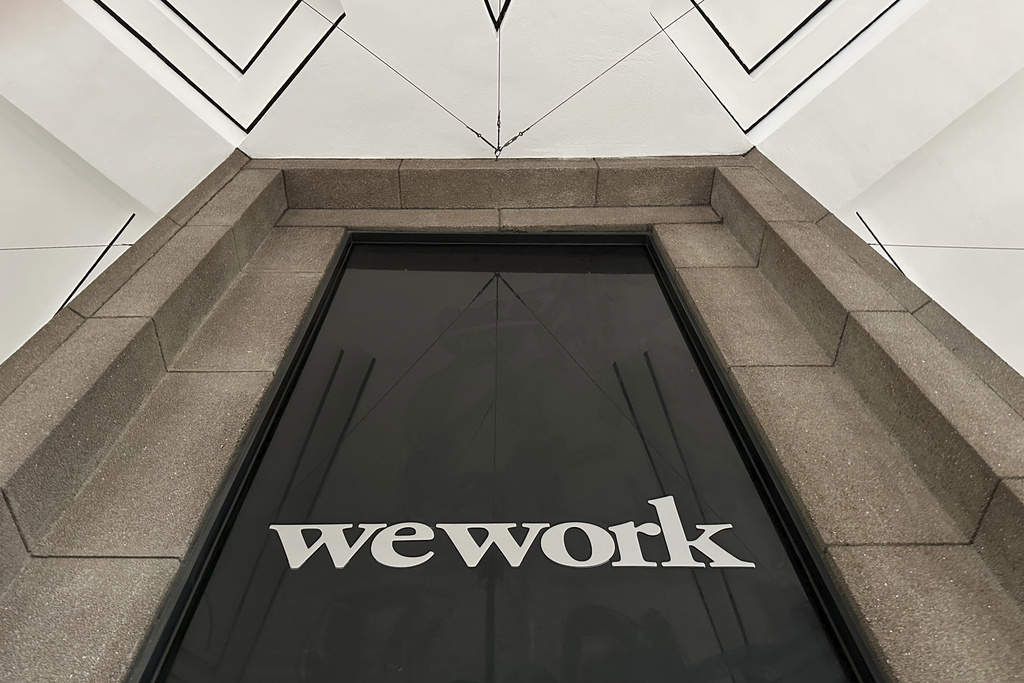WeWork has filed for Chapter 11 bankruptcy protection, marking a stunning fall for the office sharing company once seen as a Wall Street darling that promised to upend the way people went to work around the world.
In a late Monday announcement, WeWork said it entered into a restructuring support agreement with the majority of its stakeholders to slash the company’s debt while further evaluating WeWork’s commercial office lease portfolio.
This agreement is expected to erase about $3 billion of WeWork’s debt, CEO David Tolley told The Associated Press.
WeWork is also requesting the ability to reject leases for some of its locations, which the company says are largely non-operational, as part of the filing. Just over 70 leases will be rejected right at the beginning of the process, according to Monday’s filing. WeWork says all affected members have received advanced notice.
How many WeWork locations will remain operational going forward is not known. Tolley said Tuesday that he expects WeWork to exit additional locations as talks continue with landlords — but hopes to leave as few as possible.
Lease liabilities, which currently account for about two-thirds of WeWork’s operating costs, “continues to be the company’s primary challenge,” Tolley said — pointing to the need of establishing “a more efficient footprint.”
The specter of bankruptcy has hovered over WeWork for some time. The New York company sounded the alarm over its ability to remain in business in August — and soon announced its plans to renegotiate nearly all of its leases in September. But cracks had begun to emerge several years ago, not long after the company was valued as high as $47 billion.
WeWork is paying the price for aggressive expansion in its early years. The company went public in October 2021 after its first attempt to do so two years earlier collapsed spectacularly. The debacle led to the ouster of founder and CEO Adam Neumann, whose erratic behavior and exorbitant spending spooked early investors.
Japan’s SoftBank stepped in to keep WeWork afloat, acquiring majority control over the company. WeWork shareholders are largely wiped out though SoftBank, which owns nearly 80% of the equity distributed in the company, is likely still in negotiations after losing billions of dollars.
In a prepared statement Monday ahead of WeWork’s official announcement, Neumann called the bankruptcy filing disappointing and said it’s been challenging for him “to watch from the sidelines since 2019 as WeWork has failed to take advantage of a product that is more relevant today than ever before.”
Still, he added, a strong reorganization could allow WeWork to emerge successfully.
Despite efforts to turn the company around since Neumann’s departure — including significant cuts to operating costs and rising revenue — WeWork has struggled in a commercial real estate market that has been rocked by the rising cost of borrowing money, as well as a shifting dynamic for millions of office workers now checking into work remotely.
“We’ve only seen a limited recovery in office space utilization, and hybrid work patterns are becoming more entrenched than I think many people the market would have expected a couple of years ago,” said Sam Chandan, director of the Chao-Hon Chen Institute for Global Real Estate Finance at New York University’s Stern School of Business. “So there’s a long term, very significant impact on office space demand overall.”
There’s also rising competition in the flexible office industry, and that includes some legacy office landlords competing directly with co-working space providers today, Chandan said. Still, it’s important to separate WeWork’s current situation with the future of various co-working models as a whole, he said, pointing again to the company’s rapid expansion in the early years.
“Overall demand for co-working space we expect will remain healthy, and in some cases will grow,” Chandan said. “But there is variation within co-working (and) a number of different delivery models.”
In Monday’s filing, WeWork listed about $18.7 million in debts and $15.1 million in assets as of June 30. In its most recent filing that includes figures, WeWork operated 777 locations in 39 countries.
Beyond real estate costs, WeWork has pointed to increased member churn and other financial losses. In August, the company said that its ability to stay in operation was contingent upon improving its liquidity and profitability overall in the next year.
WeWork’s bankruptcy filing arrives at a time of incredible disruption in the commercial real estate market. The COVID-19 pandemic led to a spike in vacancies and major markets, from New York to San Francisco, are struggling.
In the U.S., experts note that WeWork’s 18 million square feet is a small fraction of total office inventory in the country — but on a market-by-market and building-by-building level, landlords with exposure to WeWork could take significant hits if their leases are terminated.
While the full impact of this week’s bankruptcy filing on WeWork’s real estate footprint is still uncertain, Tolley and the company sounded an optimistic note.
“Our spaces are open and there will be no change to the way we operate,” a WeWork spokesperson said. “We plan to stay in the vast majority of markets as we move into the future and remain committed to delivering an exceptional experience and innovative flexible workspace solutions for our members.”
WeWork locations outside of the U.S. and Canada will not be affected by the proceedings, the company said, as well as franchisees worldwide.
(AP)











